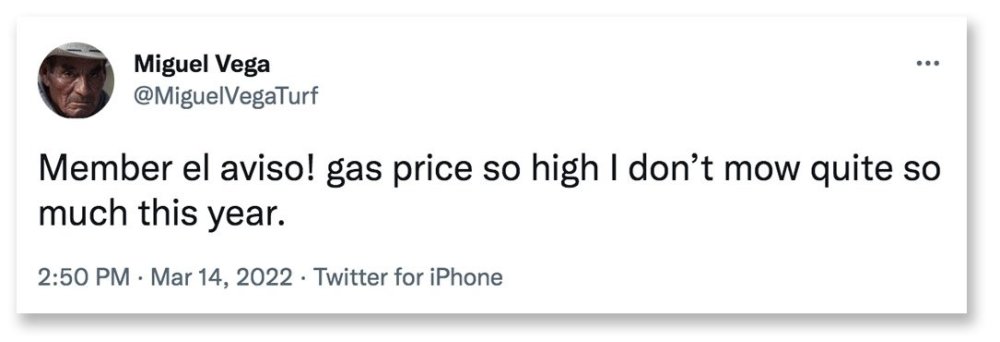A satirical social media account by a fictitious, yet funny, greenkeeper hints that rising fuel costs have become so high that the budget-busting prices might cut into his ability to mow greens this year at his make-believe "golfing course."
Although the account represents a parody of life as a golf course superintendent, some of the views of the imaginary Miguel Vega are all too real.
A total of 518 million rounds were played in 2021. That matches the number of rounds played in 2000, which then were the most ever. Although there has been record play on golf courses nationwide during the past 24 months, the rising cost of goods and services definitely are cutting into profits.
Just ask Steven Scott, owner of Persimmon Hills Golf Course in Sharon, Tennessee. A distributor spent about $100 in gas to make the nearly 600-mile round trip from Chattanooga to Sharon. This year, the same distributor spent about $250 to make the same delivery run.
"There is a huge trickle down from fuel costs," Scott said. "The cost for vendors to get product to you is going way up.
"I know somewhere down the line, it's going to catch up to me, and I'm going to be paying that $250."
Rounds played at Persimmon Hills were up more than 50 percent in 2021 compared with pre-pandemic numbers in 2019, Scott said. Although revenue is up, profits have not gone up at the same rate.
There is a huge trickle down from fuel costs. The cost for vendors to get product to you is going way up. ... I know somewhere down the line, it's going to catch up to me, and I'm going to be paying that $250.
"Before Covid, golf wasn't going gangbusters around here. We knew how to hold stuff together with duct tape and baling wire, and that's how we operated," Scott said. "Last year, there was more golf played than any other year in history, so revenue was up, but with inflation, it's almost a wash. We haven't changed a whole lot from how we were operating pre-Covid."
Each year, Scott relies on suppliers and distributors when creating a budget. Vendor partners are trusted allies in helping forecast prices for the following fiscal year. That has not been so easy for the past two years, and probably will not get easier any time soon.
According to the Capital Group, a Los Angeles-based financial services firm, the economy historically lags throughout midterm election years and then rallies after voters cast their ballots in November. Mix in the tail end of a worldwide health crisis, inflation, record-high gasoline prices and a war in Europe that combined threaten to launch another recession, and suddenly predicting prices for products produced in a global economy becomes much more of a challenge.
In December, Chris Gray of Lebanon Turf wrote about how supply shortages of urea caused a spike in fertilizer prices. Some products doubled in price, while others jumped by more than 200 percent, compared with 2021. The fertilizer market took another body blow in March with the Russian invasion of Ukraine. Russia, the world's leading producer of urea, is No. 2 globally in potash exports. Belarus, the neighboring Russian puppet state, is the third-leading exporter of potash. The volatility of the area will continue to cause limited availability of both urea and potash for the foreseeable future, Gray wrote. Throw in economic instability and forecasting price increases of anything has become much more difficult.

"Even when prices went up, it was never much," Scott said. "It might be $2 or $3 more a bag for fertilizer or herbicide, or a couple more dollars a gallon for something else, but it was never what it is now. They were always able to forecast price increases then, but now, things just keep happening," Scott said. "Even before Russia and Ukraine, there was inflation, and it's a midterm year, so the stock market is going bonkers. There are just a lot of factors (vendors) are unable to predict.
"Right now, it's hard to pin down what it's going to be from one week to the next."
Even the cost of PVC rose steadily throughout 2021 until it spiked in September by nearly 30 percent, then dropped by 20 percent in October. Since January 2021, the price of polymers used to manufacture PVC are up by 21 percent, according to Investing.com. That increase eventually is handed down to the customers, making irrigation projects more expensive, too.
"Luckily, we're set on everything we need for the year through our EOP program," Scott said. "If we have a breakthrough and there's something we need that I don't have on the shelf, then we just have to bite the bullet and do it."
Western Tennessee and the Silicon Valley are worlds apart, but there are some things that Persimmon Hills and La Rinconada Country Club in Los Altos, California, share, such as the rising cost of just about everything used on a golf course.
I usually use 100 to 120 bags of perennial ryegrass for divot repair and slit seeding. This year, I just bought every bit I could find.
La Rinconada superintendent Kevin Breen has been using some organic nutrition products for years. The price of organics has lagged behind that of synthetics, prompting him to use more of them this year and last.
"It's disruption that often gets us to change," Breen said. "And that is what we are going through right now."
At Valley Country Club in Aurora, Colorado, superintendent Zach Bauer is about halfway through a fiscal year that began Oct. 1. A great deal of planning and constant communication with members have helped him through increased costs for everything, including an anticipated jump in labor expenditures.
"I did my due diligence last year. I went to distributors during the golf season last year and asked where they thought prices would be going," Bauer said. "I must have talked to eight sales reps to make sure I could get as much into my budget as possible."
For example, he was able to raise his fertilizer budget by 37 percent, compared with the 2020-21 fiscal year.
"I got in on early buying, and I'm paying 40 percent more than (2020-21), so I'm 3 percent over budget," he said. "Because I did my due diligence, I'm a lot closer than if I'd just said 'OK, about 20 percent more will do it.'
"I have not bought fertilizer for fall yet. I usually do two slow-release apps, one in the spring and one in the summer. This year, maybe i stretch the one in summer to get me more into fall."

Seed prices, too, are still up. That is, when Bauer can find it.
"I usually use 100 to 120 bags of perennial ryegrass for divot repair and slit seeding," he said. "This year, I just bought every bit I could find."
Then there is the supply chain glut, that compared to inflation and fuel, seems like old news by now. He probably will see this year's golf season come and go before a skid steer that has been on order since last August arrives at Valley CC.
"I might not see it until August this year," he said. "It is what it is."
We know we're going to be spending more on labor this year. With inflation, everyone is demanding more money. I've had it in the back of my head for the past four months that we're not spending anything over winter. We're saving it all for those six or seven months out of the year when membership doesn't want any excuses.
Throughout every challenge, Bauer has been sure to keep his members, board and administration in the loop.
"A lot of our members are contractors or in construction, so when I talk to them about this, they get it," he said. "Where I did have to go in depth was about seed, they did not understand how there could be a shortage of seed."
To make sure he finishes the year at or under budget, Bauer has limited spending throughout the winter.
"We know we're going to be spending more on labor this year," Bauer said. "With inflation, everyone is demanding more money. I've had it in the back of my head for the past four months that we're not spending anything over winter. We're saving it all for those six or seven months out of the year when membership doesn't want any excuses. I've told our members, our board and our CFO that we are going to be under budget over the winter, but we'll make up for that in summer.
"I got a game plan together," he said. "I've been telling my board and green committee, 'hey, a dollar isn't going as far as it used to, and we're going to have to pay more. I know they are thinking 'Zach, we know, we know from the last time you told us.' I'm just making sure they understand what is happening, why it is happening and where we are headed. I'm probably over-communicating."
That is better than getting caught by surprise - like Miggy.


